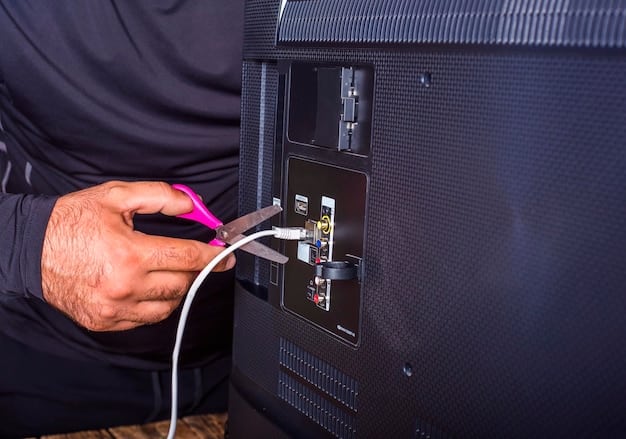4K Streaming in 2025: Your Ultimate Guide to Picture Perfection

The Ultimate Guide to 4K Streaming: What You Need to Know for the Best Picture Quality in 2025 explores the essential elements for achieving superior visual experiences, including necessary equipment, optimal internet speeds, and understanding HDR formats, alongside future trends shaping the streaming landscape.
Are you ready to dive into the world of crystal-clear visuals and immersive entertainment? This guide, The Ultimate Guide to 4K Streaming: What You Need to Know for the Best Picture Quality in 2025, will equip you with everything you need to maximize your viewing pleasure in the years to come.
Understanding the Basics of 4K Streaming
4K streaming has transformed how we consume media, offering a significant leap in picture quality compared to traditional HD. But what exactly does 4K entail, and what makes it so special?
Understanding the fundamentals of 4K streaming is essential for appreciating its capabilities and preparing your setup for optimal performance.
What is 4K Resolution?
4K resolution, also known as Ultra High Definition (UHD), delivers four times the resolution of standard 1080p HD. This translates to a clearer, more detailed picture with enhanced texture and depth.
Why 4K Matters for Streaming
4K streaming brings cinematic experiences into your living room. The enhanced detail and clarity make movies, TV shows, and even video games more immersive and engaging.
- 📈 Higher resolution means more detail: You’ll notice finer details in textures, landscapes, and facial features.
- 🎨 Improved color accuracy: 4K often includes support for wider color gamuts, resulting in richer, more vibrant colors.
- 🎬 More immersive viewing: The increased visual fidelity enhances the overall sense of realism, drawing you deeper into the content.
In essence, 4K streaming provides a visual upgrade that significantly enhances the viewing experience, making it a must-have for any entertainment enthusiast.
Essential Equipment for 4K Streaming in 2025
To enjoy 4K streaming in its full glory, you need the right equipment. This includes a 4K-compatible display, a reliable streaming device, and the necessary cables. Let’s break down each component.
Having the right setup ensures you’re not bottlenecking the 4K experience and can fully appreciate the enhanced visuals.

4K TVs and Displays
A 4K television is the cornerstone of your 4K streaming setup. Look for models that support HDR (High Dynamic Range) for improved contrast and color accuracy.
Streaming Devices: Which One is Right for You?
Streaming devices like Roku, Apple TV, and Amazon Fire Stick can deliver 4K content to your TV. Ensure your device supports both 4K resolution and HDR.
- 📺 Roku: A versatile option with a wide range of apps and user-friendly interface.
- 🍎 Apple TV: Seamless integration with the Apple ecosystem and robust performance.
- 🔥 Amazon Fire Stick: Affordable and convenient, especially for Prime Video users.
Choosing the right equipment is crucial for maximizing your 4K streaming experience. Investing in quality components ensures you’re getting the best possible picture and performance.
Internet Speed and Bandwidth Requirements
Streaming 4K content requires a fast and stable internet connection. Insufficient bandwidth can lead to buffering, reduced picture quality, and a frustrating viewing experience.
You need to meet certain minimum speed requirements to ensure smooth and uninterrupted 4K streaming.
Minimum Speed Recommendations
Most streaming services recommend a minimum internet speed of 25 Mbps for 4K streaming. However, faster speeds may be necessary for optimal performance, especially if multiple devices are connected to your network.
Tips for Optimizing Your Internet Connection
There are several steps you can take to optimize your internet connection for 4K streaming.
- 📶 Use a wired connection: Ethernet cables provide a more stable and reliable connection compared to Wi-Fi.
- 📡 Upgrade your router: A modern router can improve Wi-Fi performance and provide better coverage.
- 🌐 Reduce network congestion: Limit the number of devices using the internet simultaneously.
Proper internet connectivity is critical for enjoying 4K streaming without interruptions. Taking steps to optimize your connection can significantly enhance your viewing experience.
Understanding HDR: The Key to Enhanced Visuals
High Dynamic Range (HDR) is a technology that enhances the contrast and color accuracy of your display. When combined with 4K resolution, HDR can transform your viewing experience by delivering more realistic and vibrant visuals.
Understanding the different HDR formats and their capabilities is essential for getting the most out of your 4K content.
What is HDR?
HDR expands the range of colors and contrast that your TV can display. This results in brighter highlights, deeper blacks, and a wider range of colors, making images appear more lifelike.
Different HDR Formats: HDR10, Dolby Vision, and HLG
There are several HDR formats, each with its own set of features and capabilities.
- 🎬 HDR10: An open standard HDR format widely supported by 4K TVs and streaming devices.
Dolby Vision: A premium HDR format that offers dynamic metadata for scene-by-scene optimization.
- 📺 HLG: Hybrid Log-Gamma, primarily used for broadcast content and live streaming.
HDR is a game-changer for visual quality, enhancing the impact of 4K resolution. Choosing the right HDR format can further elevate your streaming experience.

Choosing the Right Streaming Services
Many streaming services offer 4K content, but their libraries and picture quality can vary. Selecting the right services for your needs is crucial for accessing the best 4K content.
Not all streaming services are created equal. Researching and comparing options can help you find the services that best suit your viewing preferences.
Popular 4K Streaming Platforms
Several platforms offer a wide selection of 4K content.
- Netflix: A vast library of 4K movies, TV shows, and documentaries.
- Amazon Prime Video: A growing collection of 4K content, including original series and movies.
- Disney+: Offers many of its movies and TV shows in 4K, including Marvel and Star Wars content.
Comparing Content Libraries and Quality
It’s important to compare the content libraries and picture quality of different streaming services. Some services may offer a wider selection of 4K content, while others may have better compression and streaming technology.
Selecting the right streaming services can significantly impact the availability and quality of 4K content. Carefully evaluating your options ensures you have access to the best possible viewing experience.
Future Trends in 4K Streaming
The world of 4K streaming is constantly evolving, with new technologies and trends emerging all the time. Staying informed about these developments can help you future-proof your setup and prepare for the next generation of streaming experiences.
From advancements in compression technology to the rise of 8K resolution, the future of 4K streaming is full of exciting possibilities.
Advancements in Compression Technology
New compression technologies like AV1 are emerging, which can improve picture quality while reducing bandwidth requirements. This means you’ll be able to stream 4K content with less data usage and improved performance.
The Rise of 8K
While 4K is the current standard, 8K resolution is gradually gaining traction. 8K offers four times the resolution of 4K, providing an even more detailed and immersive viewing experience. This may become standard in the coming years.
Keeping an eye on future trends can help you stay ahead of the curve and enjoy the latest advancements in streaming technology. As technology continues to evolve, the possibilities for 4K and beyond are endless.
| Key Point | Brief Description |
|---|---|
| 📺 4K Resolution | Four times the resolution of 1080p HD, offering sharper, more detailed images. |
| ⚡ Internet Speed | Minimum 25 Mbps recommended for smooth 4K streaming. |
| 🌈 HDR | Enhances contrast and color accuracy for more vibrant, lifelike visuals. |
| 🚀 Streaming Devices | Roku, Apple TV, and Amazon Fire Stick are popular options for streaming 4K content. |
Frequently Asked Questions
▼
To stream 4K content, you’ll need a 4K TV, a streaming device that supports 4K, and a high-speed internet connection, preferably with a speed of at least 25 Mbps. An HDMI 2.0 or higher cable is also recommended.
▼
Most streaming services recommend a minimum internet speed of 25 Mbps for 4K streaming. However, for a smoother experience and to accommodate multiple devices, consider an internet speed of 50 Mbps or higher.
▼
HDR stands for High Dynamic Range. It enhances the contrast and color accuracy of your TV, resulting in more vibrant, lifelike visuals. HDR significantly improves the overall viewing experience, especially when combined with 4K resolution.
▼
Several popular streaming services offer 4K content, including Netflix, Amazon Prime Video, Disney+, and YouTube. The availability of 4K content may vary depending on your subscription plan and region.
▼
Common HDR formats include HDR10, Dolby Vision, and HLG. HDR10 is an open standard, while Dolby Vision offers dynamic metadata for scene-by-scene optimization. HLG is primarily used for broadcast content and live streaming.
Conclusion
As we look ahead to 2025, 4K streaming continues to evolve, offering increasingly immersive and high-quality viewing experiences. By understanding the essentials of 4K technology, selecting the right equipment and streaming services, and optimizing your internet connection, you can unlock the full potential of 4K and enjoy the best possible picture quality. Embrace these advancements to transform your home entertainment setup and immerse yourself in the future of streaming.





